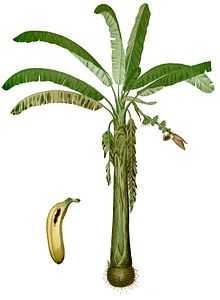Lacatan banana
| Musa acuminata 'Lakatan' | |
|---|---|
 Lakatan illustration in the 1880 book Flora de Filipinas by Francisco Manuel Blanco | |
| Species | Musa acuminata |
| Cultivar group | AA Group |
| Cultivar | 'Lakatan' |
| Origin | Philippines |


Lakatan bananas (not to be confused with the Cavendish banana Lacatan, also called Bungulan) are diploid banana cultivars from the Philippines. It is one of the most common banana cultivars in the Philippines, along with the Latundan and Saba bananas.[1]
Taxonomy and Nomenclature
The Lakatan banana is a diploid (AA) cultivar.[2]
Its official designation is Musa acuminata (AA Group) 'Lakatan'.
Synonyms include:
- Musa x paradisiaca L. ssp. sapientum (L.) Kuntze var. lacatan Blanco
- Musa acuminata Colla (Cavendish Group) cv. 'Lacatan'
The Cavendish cultivar Masak Hijau (Musa acuminata Colla (AAA Group) cv. 'Masak Hijau') is also called 'Lacatan' in Latin America and the West Indies. The cultivar Lakatan was originally described by Blanco as Lacatan, but the letter c was changed to the letter k to differentiate it from the American Lacatan which is actually a Bungulan,[3] and also called 'Jamaican Lacatan'. See Masak Hijau.[2][4]
Description
Lakatan typically grow to a height of five to nine feet. The fruits can be harvested 8 to 12 months after planting.[5] Lakatan is susceptible to the Banana Bunchy Top virus.
Lakatan fruits are longer and thicker-skinned than the Latundan bananas and turn a characteristic yellow-orange when ripe.[6][7]
Uses
Lakatan is the most popular dessert banana in the Philippines. It is more expensive than the more common Latundan and Cavendish bananas. Both Latundan and Lakatan, however, are preferred by Filipinos over Cavendish.[6]
They have higher β-Carotene content than other banana cultivars.[8]
Diseases
- Banana Bunchy Top Virus
See also
- Banana
- Banana cultivar groups
- Masak Hijau banana
- Musa
- Musa acuminata
References
- ↑ Hautea, D.M., G.C. Molina, C.H. Balatero, N.B. Coronado, E.B. Perez, M.T.H. Alvarez, A.O. Canama, R.H. Akuba, R.B. Quilloy, R.B. Frankie, C.S. Caspillo (2002-07-19). "Analysis of induced mutants of Philippine bananas with molecular markers". Institute of Plant Breeding, College of Agriculture, University of the Philippines Los Baños, FAO Corporate Document Repository. Retrieved 12 January 2011.
- ↑ 2.0 2.1 Michel H. Porcher; Prof. Snow Barlow (2002-07-19). "Sorting Musa names". The University of Melbourne, . Retrieved 11 January 2011.
- ↑ Valmayor, R.V., Espino, R.R.C. and Pascua, O.C. (2002). The Wild and Cultivated Bananas of the Philippines. Los Banos, Laguna, Philippines: PARRFI. p. 242.
- ↑ "ENCANTO FARMS "we be bananas" in San Diego". http://webebananas.com/. Retrieved 13 January 2011.
- ↑ "Lakatan Banana Growing and Production with ROI". http://www.mixph.com/. February 8, 2010. Retrieved 13 January 2011.
- ↑ 6.0 6.1 "Lacatan, Latundan & Senorita Bananas". http://www.marketmanila.com/. March 8, 2007. Retrieved 13 January 2011.
- ↑ "BANANA". Philippine Department of Agriculture http://www.da.gov.ph. March 8, 2007. Retrieved 13 January 2011.
- ↑ Lois Englberger, Ian Darnton-Hill, Terry Coyne, Maureen H. Fitzgerald, and Geoffrey C. Marks (2003). "Carotenoid-rich bananas: A potential food source for alleviating vitamin A deficiency". Food and Nutrition Bulletin, vol. 24, no. 4. The United Nations University. Retrieved 13 January 2011.
External links
| |||||||||||||||||
| ||||||||||||||||||||||||||||||||||||||||||||||||||||||
